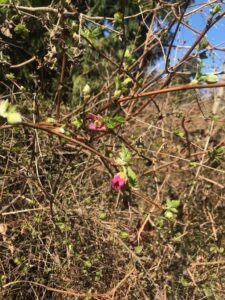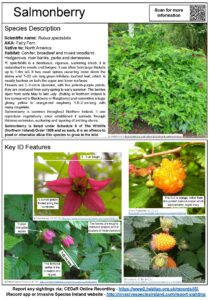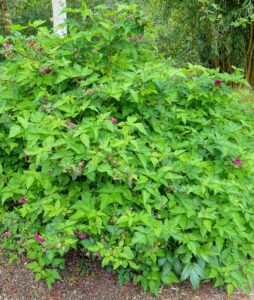Salmonberry
Rubus spectabilis
Overview
Photo credit: © Robert Flogaus-Faust, CC BY 4.0, https://commons.wikimedia.org/w/index.php?curid=84725452
Rubus spectabilis
Common Names:
Habitat:
Origin and Worldwide Distribution:
Potential or Known Impacts:

How did it get here?
Is it found in Northern Ireland?
You can help by reporting any sightings: @ the Centre for Environmental Data & Recording (CEDaR) - Or via the iRecord App.
Methods for Prevention:
Current Legislative Position (Northern Ireland only):
Rubus spectabilis
Common Names:
- Salmonberry, fairy fern
Habitat:
- Conifer, broadleaf and mixed woodland. Also found in hedgerows, river banks, parks and demesnes.
Description:
- R. spectabilis is a deciduous, vigorous, suckering shrub, it is naturalised in woods and hedges.
- It can often form large thickets 1-4m tall.
- Trifoliate leaves are 7–22 cm long, with toothed edges and are mostly hairless on both the upper and lower surfaces.
- Flowers are 2–3 cm in diameter, with five pinkish-purple petals; they are produced from early spring to early summer. The berries ripen from early May to late July (fruiting in Northern Ireland is low compared to Blackberry or Raspberry). They resemble a large glossy yellow to orange-red raspberry 1.5–2 cm long with many drupelets.
Origin and Worldwide Distribution:
- It is native to western North America. It has been introduced to Belgium, Denmark, France, Germany, Great Britain, Netherlands, Norway, Sweden (DAISIE, 2014). It is considered established in Ireland, Netherland, Norway and Sweden (NOBANIS).
Potential or Known Impacts:
- As it forms dense thickets, it may locally inhibit the regeneration of companion plant species, such as native trees in woodland.

© robinpolla CC BY-NC 4.0 https://www.inaturalist.org/photos/64190264
How did it get here?
- R. spectabilis was introduced as an ornamental plant in gardens and estates, it was also also used as game cover.
Is it found in Northern Ireland?
- Present in Northern Ireland.
- More distribution details can be found on NBN Atlas NI.
You can help by reporting any sightings: @ the Centre for Environmental Data & Recording (CEDaR) - Or via the iRecord App.
Methods for Prevention:
- Report any sightings.
- Do not plant this species – plant native species instead.
- Do not take or give cuttings from wild or cultivated plants.
- Deadhead specimens that you are removing.
- Dispose with care as it can rapidly germinate and grow in different habitats.
- Know what you are growing.
- Never collect plants from the wild.
- Safely dispose of plants and growing media.
 |
 |
 |
 |
 |
Current Legislative Position (Northern Ireland only):
- Rubus spectabilis is listed in Schedule 9 of the Wildlife (Northern Ireland) Order 1985 and as such, under Article 15 it is an offence to plant or otherwise cause this species to grow in the wild.


